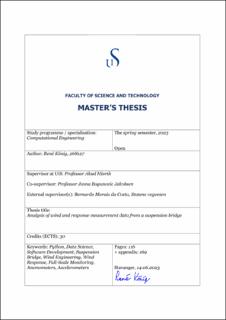| dc.description.abstract | The Lysefjord Bridge is a suspension bridge at the entrance to the Lysefjord in south-western Norway at which full-scale measurements on wind conditions and bridge response are collected using anemometers and accelerometers. In this work Python is used to develop a toolset for analysing the wind and response measurement data from the Lysefjord Bridge. The functionality is provided through different methods compiled in a class. This includes methods for importing and combining data from multiple days, re-arranging and interpreting the data, feature engineering, data cleaning, filtering and various types of visualisations. The code is demonstrated in an analysis of 30 days of data. The analysis focuses on the wind conditions for south-westerly and north-easterly winds in terms of wind speeds, primary directions, turbulence intensity and angle of attack as well as the bridges lateral, vertical and torsional wind response. The analysis shows on average slightly higher wind speeds, lower turbulence intensities and higher angles of attack for south-westerly winds, compared to north-easterly winds. Towards the southern end of the bridge the wind direction has a south tendency for south-westerly winds and north tendency for north-easterly winds. Turbulence intensity is measured slightly higher on the downwind side of the bridge. The angle of attack is straightened towards 0° on the downwind side. Furthermore, the analysis shows that the assumption of a linear correlation between drag coefficient and angle of attack used in the so-called quasi-steady theory of wind loading and the corresponding numerical simulations underestimates most of the larger lateral bridge responses at angles of attack above 0°. The lift and moment coefficients estimated using similar linearity assumptions overestimate some of the larger vertical and torsional bridge responses at angles of attack above +5°. | en_US |

